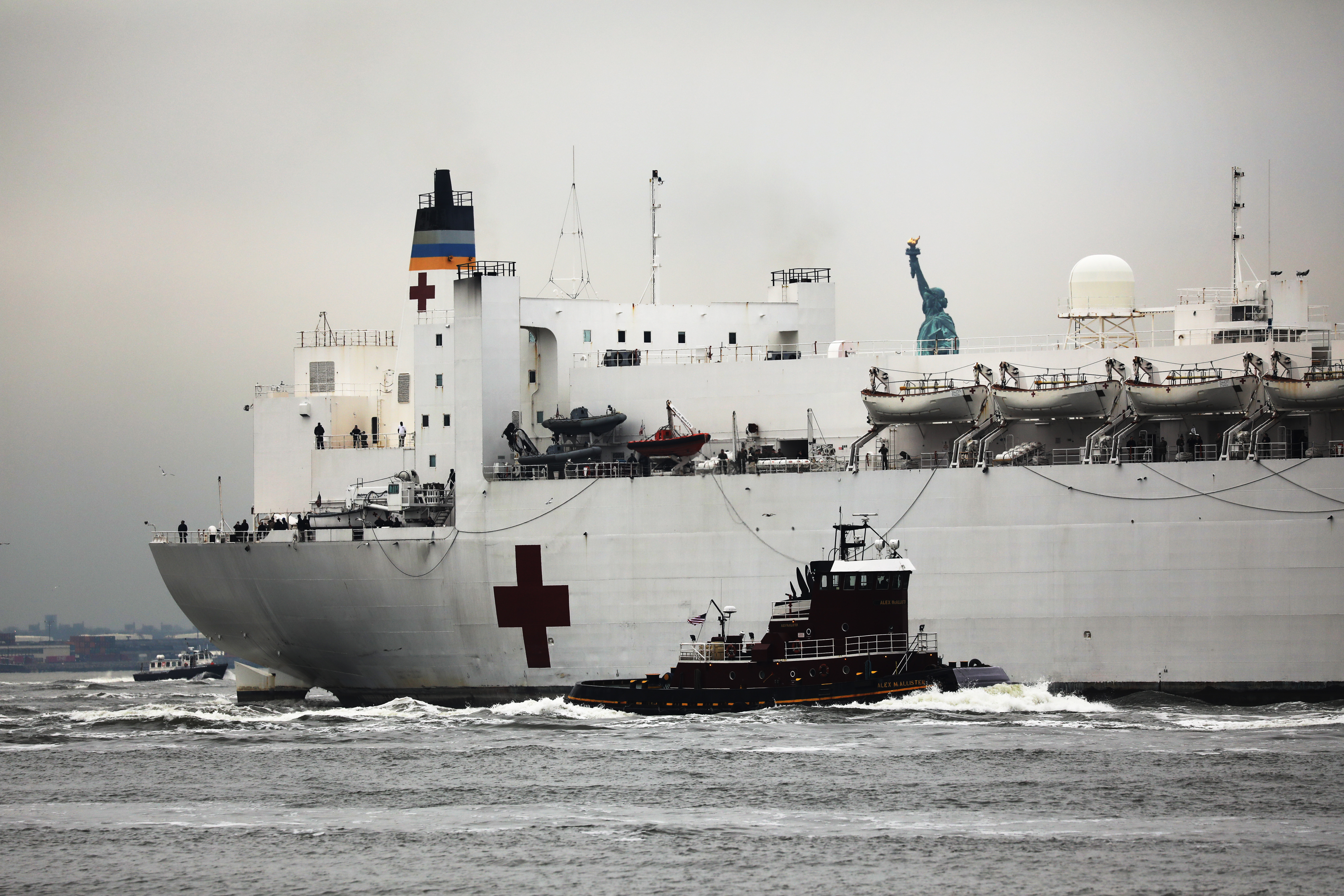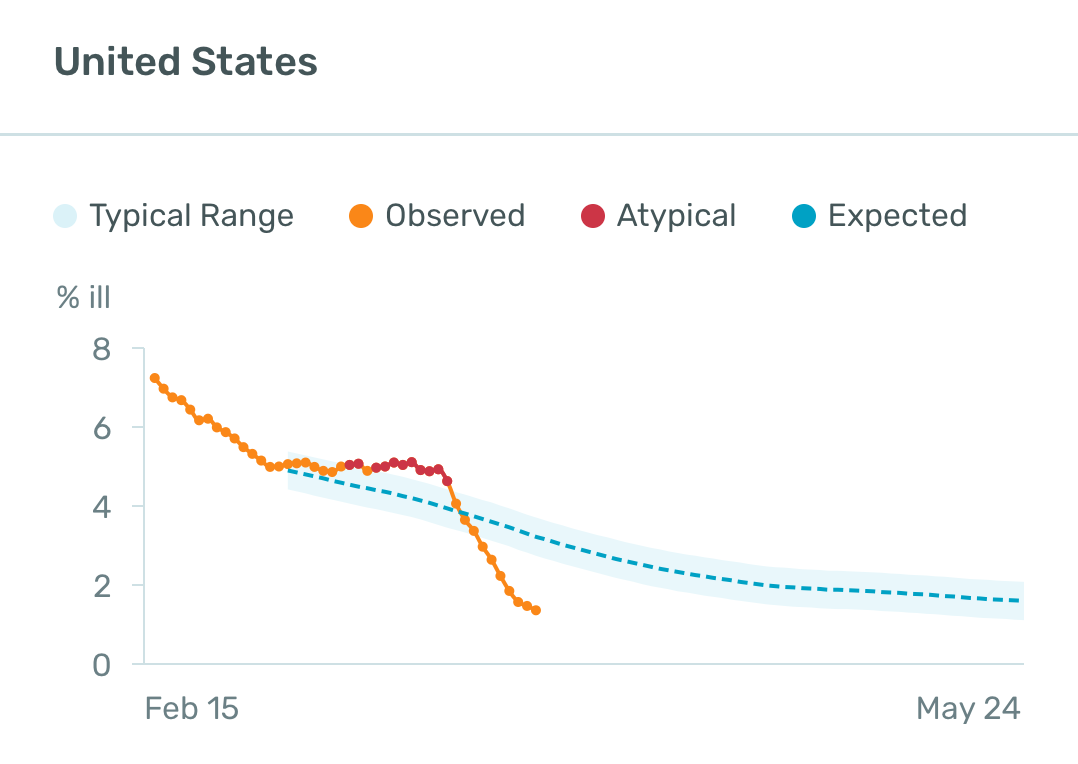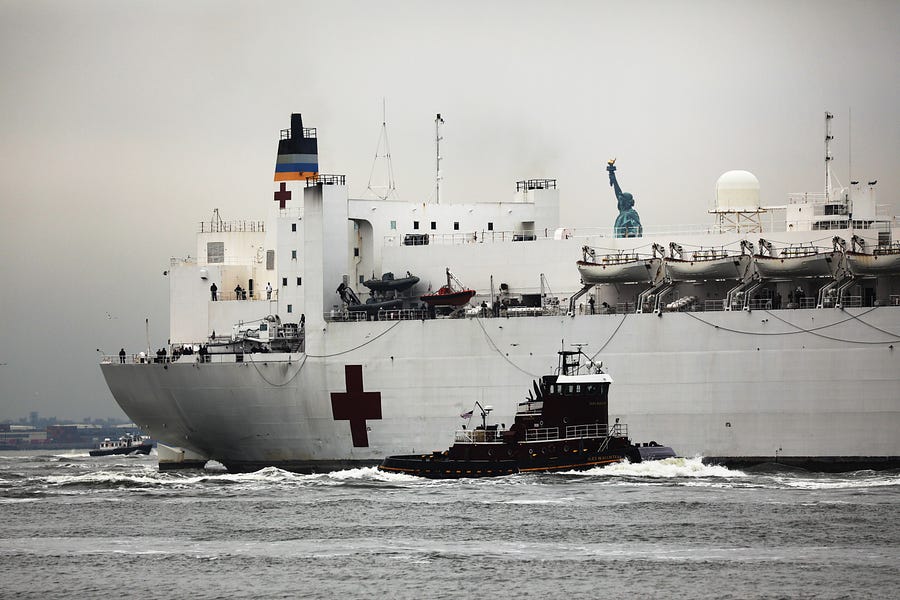Happy Tuesday. It’s getting really nice out where your Morning Dispatchers are, and we’re getting positively stir crazy—here’s hoping the weather remains foul wherever you’re reading this, to cut down on temptation!
Quick Hits: Today’s Top Stories
-
As of Monday night, there are now 164,274 confirmed cases of COVID-19 in the United States (a 15.6 percent increase from yesterday) and 3,164 deaths (a 27.6 percent increase from yesterday), according to the Johns Hopkins University COVID-19 Dashboard, leading to a mortality rate among confirmed cases of 1.9 percent (the true mortality rate is difficult to calculate due to incomplete testing regimens). Of 944,854 coronavirus tests conducted in the United States, 17 percent have come back positive, per the COVID Tracking Project, a separate dataset with slightly different topline numbers.
-
Macy’s—which closed its 775 locations due to coronavirus concerns on March 18—announced it will be furloughing most of its 125,000 employees due to the shutdown’s impact on sales. Furloughed workers will continue to receive health insurance through May, and the company hopes to bring back employees “on a staggered basis as business resumes.”
-
Johnson & Johnson is set to begin clinical trials for a coronavirus vaccine by September, and the company said it’s hopeful the vaccine will be eligible for emergency use authorization from the FDA by early 2021.
-
While the Chinese government continues to claim that about 2,500 people have died from the coronavirus in the city of Wuhan, Radio Free Asia reports the number of fatalities could be significantly higher, closer to 50,000.
-
Mark Meadows formally resigned from Congress as of 5 p.m. Monday, and will officially begin his role as President Trump’s chief of staff today, replacing Mick Mulvaney.
-
The Hungarian parliament granted Prime Minister Viktor Orbán sweeping powers to respond to the coronavirus crisis—with no expiration date. Thanks to the 137-53 vote, elections are canceled, parliament is suspended, and journalists can be punished for coronavirus reporting the government deems inaccurate.
-
A federal judge temporarily halted Texas’s abortion suspension—put in place to save medical supplies for coronavirus treatment—until April 13. Texas is expected to appeal the decision.
200,000 Deaths If We Do Things ‘Almost Perfectly’

The third full week of our new normal began with a dire warning from Dr. Deborah Birx, the coronavirus task force’s response coordinator. “If we do things together well, almost perfectly, we could get in the range of 100,000 to 200,000 fatalities,” she told NBC’s Savannah Guthrie, who responded with shock to this best-case scenario. “I think in some of the metro areas, we were late in getting people to follow the 15-day guidelines,” Birx added.
Asked about these eye-opening projections later Monday night, Birx simply said the task force would provide more graphs and information today. But she made sure to implore states across the country—even those not yet heavily affected—to remain vigilant in the face of an invisible enemy: “It may look like two cases today—that become 20, that become 200, that become 2,000.”
The loss of one life is tragic, let alone 200,000. But that figure—if we come in below it—would represent a dramatic departure from the modeled worst-case scenario of 2.2 million deaths. That latter total—when presented to President Trump—went a long way toward convincing him to extend social distancing guidelines through April 30, per Maggie Haberman and Peter Baker of the New York Times.
The larger picture fell to the public health advisers, who provided Mr. Trump with a grim prognosis in a meeting on Sunday before his announcement extending social distancing guidelines. Dr. Anthony S. Fauci, the director of the National Institute of Allergy and Infectious Diseases, and Dr. Deborah L. Birx, the White House response coordinator, showed the president models of how many people across the country could be affected if more stringent measures were not maintained.
“He looked at them, he understood them, and he shook his head and said, ‘I guess we got to do it,’” Dr. Fauci said on CNN on Monday. That meeting appeared to resonate with Mr. Trump, officials said.
In a Fox News interview on Monday, Trump said he will continue to empower public health officials on the timing of easing restrictions. “Anthony and Deborah have been doing this for many years, and I’m going to rely on them.”
Most data show we are still on the front end of this crisis—Trump himself said “the peak in fatalities will not arrive for another two weeks”—but there are some (very) early signs for optimism. Smart thermometer company Kinsa Health has been tracking fever levels across the country this month, and has already found data suggesting that social distancing just might be having an effect on the coronavirus’ spread.

The data don’t show COVID-19 cases are declining; social distancing also affects the transmission of regular old colds and flus. In fact, “we expect to see reported cases continue to surge in the near term,” the company’s website reads. But the decline in feverish illness levels “may indicate these measures [social distancing and stay-at-home orders] are starting to slow the spread.” We recommend you read Donald McNeil’s most recent piece in the New York Times for more details on this fascinating dataset.
One Problem Social Distancing Can’t Solve: Our PPE Shortage
The situation, undeniably, remains very grim. But the good news is that however far we remain from the goal of defeating this pandemic, we’re at least a small step closer than we were yesterday. The measures we’re taking are slowly beginning to work.
These measures offer hope that other major U.S. cities will not see quite the extreme level of coronaviral distress currently gripping early hotspots like New York City. This would not mean minimizing deaths outside those hotspots, but even minimizing deaths within them: the fewer areas around the country with overwhelmed hospital systems, the more the federal government and private organizations can focus triage efforts on ensuring people in hotspots receive care.
As New York’s situation has worsened, we’ve already started to see these sorts of efforts spinning into action. The USNS Comfort, a mammoth Navy hospital ship with about 1,000 beds, sailed into New York Harbor on Monday to serve as a floating hospital for non-COVID patients who have been shunted to the side by the crisis. The Army Corps of Engineers has been hard at work refitting the city’s Javits Convention Center into another 3,000-bed field hospital. Humanitarian groups have pitched in too: Evangelical organization Samaritan’s Purse has set up another pop-up hospital for coronavirus patients in the middle of Central Park.
As social distancing continues to slow the virus’s community spread, however, there’s a parallel problem that’s only getting worse: the lack of adequate personal protective equipment for hospital workers across the country. Dwindling reserves of such indispensable gear as protective masks and gowns have prompted widespread rationing even outside hotspots and sparked protests from medical professionals across the nation.
“I think that things just continue to very gradually worsen,” Dr. Andrew Cureton, an urgent care physician in D.C.’s Virginia suburbs, told The Dispatch. “There’s been a very steady decline in terms of the standards that external bodies like the CDC are holding hospitals to. And hospitals have mostly run with that. They’re still trying to do what they can to protect the people that are most critical to the effort, like respiratory therapists. But general exposures are really being put on the back burner.”
In an effort to stretch PPE as far as possible, Cureton said, some hospitals have begun requiring staff to do things like wear a single disposable mask for an entire shift: “things that are really extreme and would be unsafe to other patients in any other circumstance are kind of the best we can do here.”
A raft of private companies, from Fortune 100 manufacturers like Honeywell to infomercial jockeys like MyPillow, have pledged to divert production to address the shortage. It can’t come soon enough: Unless and until those stores are replenished, hospitals intending to treat the coronavirus may actually become some of the more dangerous hotbeds for its spread.
“We interact in a very close physical way with so many people who are particularly vulnerable,” Cureton said. “And when we allow the normal staff to become infected, because this is absolutely in the community at this point, then we’re going to be infecting other people further down the line.”
You might not have opened this newsletter expect to hear an eloquent monologue on the acute need for additional PPE from longtime WFAN sports radio host Mike Francesa, but we don’t live in ordinary times. “Get the stuff made, get the stuff where it needs to go, and get the boots on the ground, treat this like the crisis it is!”
The Inside Story of The Trump Presidency
When Donald Trump fired off six tweets in a row on Sunday about the ratings of his daily coronavirus briefings, the tone deafness surprised even some of his most reliable supporters.
With thousands of new coronavirus cases each day and a death toll climbing by hundreds, they wondered, how could the president possibly care about the ratings of his briefings?
One person who was likely not surprised? Jonathan Karl, chief White House correspondent and author of Front Row at the Trump Show, an insightful and highly readable new book on the Trump presidency, out today. “I call it the Trump Show because that is the way President Trump sees it,” Karl writes in the introduction. “He tracks the ratings and the crowds. He follows the reviews. He slams the critics but craves their approval. And when he can’t get their approval, he sets out to prove them wrong by point to his adoring fans and showing that he can command the world’s attention by changing a story line any time he wants to change it.”
Karl has known Trump since first interviewing him more than two decades ago (when, as a cub reporter for the New York Post, he got Trump to divulge all kinds of details about the Trump Tower honeymoon of Michael Jackson and Lisa Marie Presley). Karl, who is currently the president of the White House Correspondents Association, has also covered the presidencies of Bill Clinton, George W. Bush, and Barack Obama. The book reflects both this intimate knowledge of his subject and his understanding of the job.
Front Row at the Trump Show is the best long-form study of the relationship between Trump and the media—and it’s not possible to understand the Trump presidency without understanding that relationship. Perhaps not surprisingly, Karl is unsparing in his critique of the president, writing that Trump “is waging a war on truth, helping to convince millions of Americans that real news is fake, that journalists are partisans out to get him.” But Karl regularly turns the camera around on his colleagues, capturing their excesses and criticizing their conduct. “The truth is that the mainstream media coverage of Donald Trump is relentlessly and exhaustively negative,” he writes. “His accomplishments—and there are accomplishments—are either ignored or overshadowed by the drumbeat of outrage fueled by his own outrageous behavior.”
The book documents those accomplishments, but also provides in-the-room details of that outrageous behavior and the lengths top White House officials have gone to keep the president on track. But Trump is Trump. He’s not going to be constrained by his most powerful aides, and he’s likely to ignore even their most well-intentioned advice. Karl draws on his access to all of the key players in Trump world, including the president, to tell the often unbelievable story of this most unusual presidency.
Worth Your Time
-
This audio essay from New York Times deputy editor Jessica Lustig, about the process of caring for her husband sick with COVID-19 at home, is bracing to listen to (or read): “It’s as if we are in a time warp, in which we have accelerated at one and a half time speed, while everyone around us remains in the present—already the past to us—and they, blissfully, unconsciously, go about their ordinary lives, experiencing the growing news, the more urgent advisories and directives, as a vast communal experience, sharing posts and memes about cabin fever, about homeschooling, about social distancing, about how hard it all is, while we’re living in our makeshift sick ward, living in what will soon be the present for more and more of them.”
-
Wearing surgical masks in public places has long been a part of life in some East Asian countries, a cultural phenomenon that likely helped early coronavirus containment efforts in places like South Korea and Hong Kong. In this National Review piece, Michael Brendan Dougherty takes a look at the ways in which, by contrast, a distrust of masking is philosophically embedded in Western cultures, and why we’re likely to retain our dislike of public masks once the current crisis, and their current usefulness, has run its course.
-
Netflix’s new Tiger King documentary is sweeping the nation; we’d be remiss not to share an older, equally amazing look into the wild life of Oklahoma big cat wrangler Joe Schreibvogel, aka Joe Maldonado-Passage, aka Joe Exotic: This bonkers Texas Monthly piece written by Leif Reigstad last June.
Presented Without Comment
Also Presented Without Comment
Something Fun
We like good news and we often seek to highlight it. But here’s a little rule of thumb your Morning Dispatchers have found helpful in life: Sites and shows that exist only to share “good, uplifting news” are usually tiresome, clickbaity, and twee. But not even grinches like us could resist John Krasinski’s new “Some Good News” YouTube channel, which launched Sunday with a pile of feel-good stories and an interview with the show’s “Entertainment Correspondent”—Krasinski’s former The Office co-star Steve Carell.
Toeing the Company Line
-
On the latest Advisory Opinions podcast, Sarah and David are joined by Rep. Chip Roy of Texas to discuss all aspects of the government’s coronavirus response. Then they talk about Tiger King.
-
If you missed it yesterday, go back and read Sarah’s legal explainer of how Chapter 11 bankruptcy is another way to deal with the financial hardships that the airlines are facing.
-
On the site today, Dominic Dent (yes, that’s Alec’s brother in case you were wondering), shares his tale of flying home from France to the United States in late March—a journey during which screening for coronavirus amounted to … filling out a questionnaire.
-
Also on the site, Ryan C. Black, Timothy R. Johnson, and Ryan J. Owens team up to argue that it’s better to postpone the Supreme Court cases on the docket rather than decide them without oral arguments.
Let Us Know
The physical and financial hardships COVID-19 have wrought on millions across the globe are the worst aspects of this pandemic. But also among the virus’ most unfortunate features is its ability to wipe out some of the very activities and diversions that could help ease us through these scary times. What’s the one thing that—were it restored—would make these next several weeks so much easier? What will you never take for granted again?
Reporting by Declan Garvey (@declanpgarvey), Andrew Egger (@EggerDC), Alec Dent (@Alec_Dent), Sarah Isgur (@whignewtons), and Steve Hayes (@stephenfhayes).
Photograph of the USNS Comfort by Spencer Platt/Getty Images.







Please note that we at The Dispatch hold ourselves, our work, and our commenters to a higher standard than other places on the internet. We welcome comments that foster genuine debate or discussion—including comments critical of us or our work—but responses that include ad hominem attacks on fellow Dispatch members or are intended to stoke fear and anger may be moderated.
With your membership, you only have the ability to comment on The Morning Dispatch articles. Consider upgrading to join the conversation everywhere.